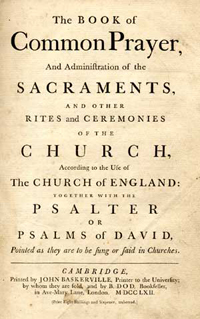
TREVOR GRUNDY, of ENInews, reports…
“Ashes to ashes, dust to dust.” “All the deceits of the world, the flesh and the devil.” “Read, mark, learn, and inwardly digest.”
Shakespeare? The King James Bible? Close – the Anglican Book of Common Prayer, the liturgical and literary masterpiece that (next to the previous two sources) has helped shape the English language and marks its 350th anniversary this year.
 |
|
INFLUENTIAL BOOK: Title page of the Prayer book of 1662, as printed by John Baskerville in 1762. PICTURE: Wikipedia. “I hope and pray that people in Britain and around the English-speaking world realise the importance of this great work.”– Prudence Dailey, chair of the Prayer Book Society in the UK |
St Paul’s Cathedral in London celebrated the occasion on 2nd May with a special service of evensong, or evening prayer, from the 1662 volume, often shortened to the BCP or Prayer Book. Archbishop of Canterbury Rowan Williams attended, along with members of Prayer Book societies in Australia, Canada and the UK that are dedicated to keeping the work alive.
“I hope and pray that people in Britain and around the English-speaking world realise the importance of this great work,” Prudence Dailey, chair of the Prayer Book Society in the UK, told ENInews.
The service is the flagship of a nationwide series of events that includes an exhibit at Lambeth Palace Library that acknowledges the 60th anniversary of Queen Elizabeth II’s coronation, looking at the relationship between the monarchy and the Prayer Book. It includes a copy of the first Prayer Book, published in 1549, and the copy used at Queen Victoria’s wedding.
The anniversary actually refers to the revised edition that still stands as the official doctrinal standard of the Church of England and most other churches in the worldwide Anglican Communion.
After Henry VIII’s break with the Roman Catholic Church, Archbishop of Canterbury Thomas Cranmer set out to replace the Latin missal with a book of liturgical services and prayers in English that would also incorporate theological changes, such as less prominence for saints.
The Prayer Book now appears in many variants in the 77 million member Anglican Communion and has influence the liturgical texts of other denominations.
It has proved “very adaptable over the centuries and has been used in many contexts. Many people do prefer the less convoluted language of modern services but the influence of the old Prayer Book permeates the new versions, with many prayers incorporated with minimal changes,” Rev Gordon Jeanes, a former lecturer in church history at the University of Wales, who appeared at a symposium on the BCP last March at the British Academy in London, told ENInews.
The book’s language – another phrase is “till death us do part” from the marriage service – resonates even today, said Bishop Stephen Platten of Wakefield (Yorkshire), chair of the Church of England’s Liturgical Commission. “Even in an apparently secular world, large numbers come to have their children christened or baptised. The cadences of the Prayer Book have become part of a treasury of prayers and reflections that have helped to fashion people’s lives,” he told ENInews.
But the Prayer Book’s language, though appreciated, has been subject to revision and various Anglican churches have produced updated versions.
In the US, for example, the break with Britain in 1776 left church leaders feeling the need for their own Prayer Book.
“William White, the first Presiding Bishop of the Episcopal Church, spoke of the need for ‘a church government that will contain the constituent principles of the Church of England and yet be independent of foreign jurisdiction or influence,'” noted Rev C.K. (Chuck) Robertson, Canon to the Presiding Bishop of the Episcopal Church, in an interview with ENInews.
He added: “By definition, this meant the creation of a new American form of the Book of Common Prayer.” Rev Robertson said that as the nation grew, so also has the church in America and three Prayer Book revisions have since emerged. The latest, the 1979 edition, reflects an appreciation of heritage while also taking into account more recent liturgical forms.
He added that, “it should be noted that even in England, though the 1662 book remains the official Prayer Book of the Church of England, most congregations on a regular basis use their own revised texts, including the recently produced Common Worship.”





